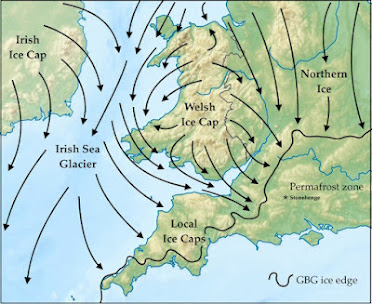"That boat doesn't float any more," says MPP when asked about the glacial transport hypothesis in his public meetings.
Well, it's very much afloat, and the new research just published by Gibson and Gibbard provides powerful new evidence which confirms the existence of a powerful Irish Sea Ice Stream carrying far-travelled erratics and affecting all of the coasts on the southern flank of the Bristol Channel. What's new about this research is that it switches away from our old obsession with the Anglian Glaciation, and makes a convincing case for an exensive Wolstonian / MIS 6 glaciation instead. Their evidence looks solid, especially for the West Midlands, and although it can be criticised in detail, there now seems to be sufficient dating information to justify the MIS 6 designation.
I will have to revise a lot of my dating as laid out in previous posts on this blog! I can live with that. Of course, the Anglian glaciation has not been dismissed out of hand as a possible "erratic carrying glacial episode" -- and it's emerging that in some parts of the UK it was more extensive than the Wolstonian ice cover, and in some parts less extensive.
But now we can suggest that many of the giant erratics on the Bristol Channel coasts were emplaced during the Wolstonian glacial episode, and that it is highly likely that ice from the Bristol Channel pushed into the Parrett Basin or Somerset Levels, possibly as far as the edge of the chalk escarpment. As I have suggested before, the situation in the South-West will have been messy, with small Dartmoor and Exmoor ice caps and extensive perennial snowfields incorporated within the easternmost ice edge:
This is my representation of the Late Devensian situation -- with a powerful Irish Sea glaciation, but less extensive than the Wolstonian equivalent.



No comments:
Post a Comment